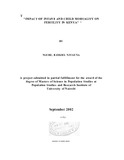| dc.description.abstract | The present unprecedented growth of population around the world has made it imperative to
understand the causes and look for cure of this growth. Fertility and mortality are the two
important factors that contribute to this growth. An important demographic question that has
been widely investigated recently is the degree to which changes in infant and child mortality
can be expected to induce changes in fertility rates in developing countries. This study tries
to answer this question by investigation the impact of infant and child mortality on fertility in
Kenya.
This study utilizes 1998 Kenya Demographic Health Survey (1998 KDHS) data Conducted
between February 1998 and August 1998. A study sample of women aged 35 years and
above excluding those who have never been married and those who had never given birth
was taken from this data. Ordinary Least Squares (OLS) and Two Stage Least Squares
(2SLS) statistical methods were used to estimate direct effects of infant/child death(s) on
fertility and replacement rate respectively.
The motivariate analysis results showed that, there exist direct effects of infant/child death(s)
on fertility. Women who experienced infant/child death(s) had a higher number of children
ever born. The result also showed that the replacement rate for the period of 1993 to 1998
was 0.27. This was lower compared to that of the period 1989 to 1993 which was 0.3 using
Two Stage Least Squares method .
In the differentials, replacement rate was positively related with education and Infant/Child
death(s) among women with no education was not significant in explaining fertility. When
the analysis was carried out by type of place of residence, replacement rate was higher in
rural areas than in urban areas. Infant/child death(s) was found to be insignificant in
explaining fertility in urban areas. There was no significant difference in replacement when
the analysis was carried out between low and high mortality regions.
For policy concerns, the study recommends programmes aimed at reducing infant and
mortality should be integrated into programmes geared towards fertility reduction. This can
be done by also promoting programmes that promote child nutrition and child care. Other
programmes promoting girl child education (especially higher education), contraceptive use
and age at first marriage should be implemented and strengthen those that are already
existing. For further research, the study recommends further research on effects of School
dropout on fertility and further investigations on Minimum Distance Estimation Model on
Kenyan data. | en |

